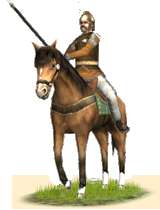Asya Badarai (Saka Heavy Cavalry)
 |
Weapons | Defence | Mental | ||||||
|---|---|---|---|---|---|---|---|---|---|
| Primary | Secondary | Armour: | 6 | Morale: | 13 | ||||
| Type: | spear | axe | Shield: | 0 | Discipline: | disciplined | |||
| Attack: | 4 | 8 | Skill: | 11 | Training: | highly_trained | |||
| Charge: | 34 | 15 | Recruitment | Other | |||||
| Lethality: | 0.4 | 0.165 | Soldiers: | 25 | Hit Points: | 1 | |||
| Range: | 0 | 0 | Cost: | 1977 | Mass: | 1 | |||
| Ammo: | 0 | 0 | Upkeep: | 494 | |||||
| Turns: | 1 | ||||||||

The Saka Lancers can charge with devastating effect, but, being largely unarmored, they should not be allowed to engage in hand-to-hand combat for long nor become the target of enemy archery.
Disciplined
Hardy
Wielding a two-handed kontos and riding fast and strong horses, the Saka Lancers are capable of mounting a powerful charge. Their second weapon is a sagaris battleaxe, effective against armor, so they can inflict substantial damage even to well-protected enemies in close hand-to-hand combat. However, they do not wear much armor themselves, only a helmet and a leather jacket or corselet, and, consequently, they are likely to suffer casualties in forced to engage in a protracted melee. They will also be somewhat vulnerable to archery. The charge is certainly the strongest point of Saka Lancers and a wise commander will seek to use them in a way that maximizes the benefits from this ability. Charging and a quick retreat, only to charge back again, and a judicious selection of the target in terms of both moment and location should probably be their standard mode of operation in the battlefield.
Historically, the Makedonian invasion of the Achaemenid Empire brought the nomads of the Central Asian steppes, peoples with a long tradition of cavalry warfare of their own, into contact with horsemen charging into contact with the enemy using long lances as done by the Makedonian Hetairoi. The nomads were quick to incorporate this innovation into their own practices, and the partnership of mounted lancers and horse archers would define warfare in the Eurasian steppes for centuries to come. Along history, mounted lancers often wore substantial amounts of armor, at times extended to their horses, as seems fitting for troops destined to engage their enemies at close quarters. However, we also have evidence contemporary with the nomad-Makedonian contact or shortly after it (a terracotta from Koi-Krylgan-Kala, modern Uzbekistan, for example) for unarmored riders atop unprotected horses, wielding long, two-handed lances.